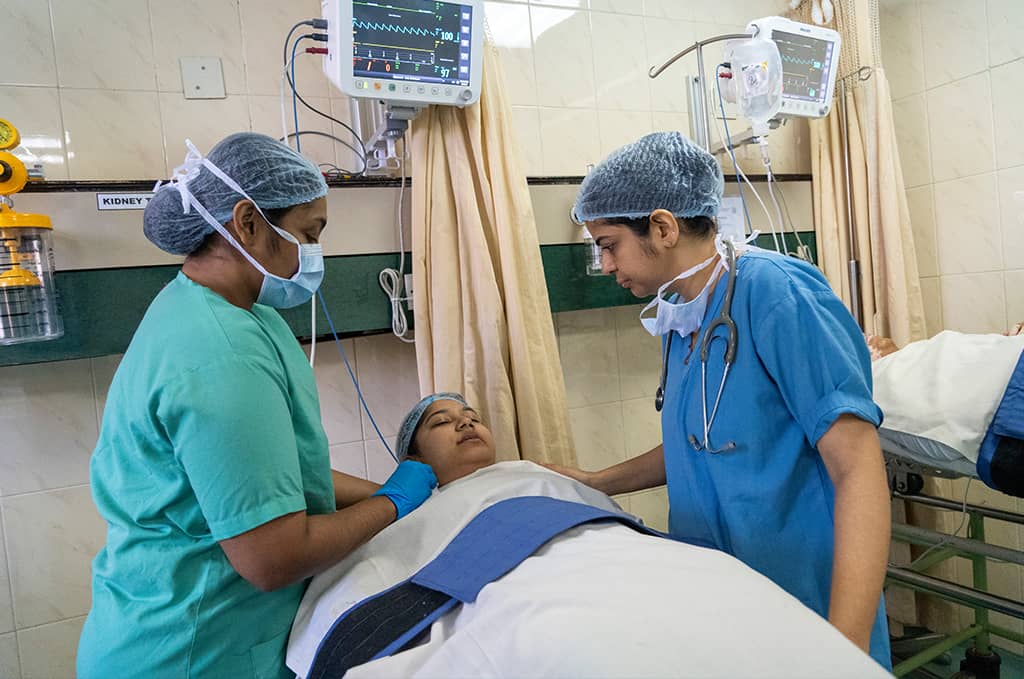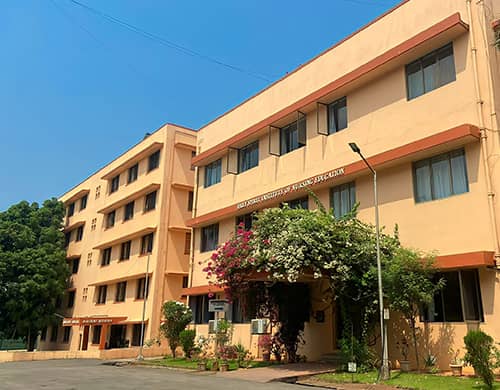Our Departments
Anaesthesiology
Overview
Welcome to the Department of Anaesthesiology at Holy Spirit Hospital
At Holy Spirit hospital, our Department of Anaesthesiology is dedicated to providing safe, effective and compassionate care to our patients. As a 300-bedded multi-specialty hospital, we are equipped with state-of–art technology and a highly skilled team of anaesthesiologists, ensuring optimal patient outcomes.

Services
Our department offers a comprehensive range of anaesthetic services, including:
General Anaesthesia:
General Anaesthesia involves the administration of anaesthetic agents that result in the complete loss of consciousness, sensation, and awareness, allowing surgeons to perform complex operations safely without causing pain or distress to the patient. Its careful administration and monitoring are key to ensuring patient safety and comfort.
Regional Anaesthesia
Regional Anaesthesia is used to provide targeted pain relief to specific areas of the body while allowing the patient to remain conscious. Key Techniques in Regional Anaesthesia include spinal anaesthesia, epidural anaesthesia and peripheral nerve blocks.
Spinal and Epidural Anaesthesia: These approaches is advantageous in various surgical procedures, particularly those in the lower body surgeries as it can reduce the need for general anaesthesia and minimize post-operative pain. They offer effective alternative to general anaesthesia providing targeted extended pain relief intraoperative as well as the post-operative periods.
Labour epidurals are given to smoothen the process of normal delivery, alleviating the pain and making it a pleasant experience for the new mother.
In Peripheral Nerve Blocks, we use anatomical landmarks or ultrasound guidance, a needle is inserted near the nerve to deliver the anaesthetic agent. It provides focused pain relief with minimal systemic effects and can be used for extended post-operative pain management by insertion of continuous infusion catheters.
Monitored Anaesthesia Care (MAC)
Commonly used for outpatient procedures such as colonoscopies, dental surgeries, endoscopies, and minor orthopedic procedures. We ensure adequate sedation and pain control while allowing for rapid recovery. Patients typically have a quicker discharge time and can often resume normal activities sooner than those undergoing general anaesthesia.
Pain Management
Pain management refers to specialized services aimed at alleviating chronic pain conditions through various advanced techniques and therapies as follows:
- Interventional Procedures: Techniques such as nerve blocks, epidural steroid injections, and radiofrequency ablation under C-arm guidance are commonly used to target specific nerves or areas of the body to alleviate pain.
- Medication Management: Utilization of a combination of analgesics, anti-inflammatory drugs and adjuvants (e.g., anti-depressants, anti-convulsants) to manage pain effectively.
Infrastructure and Technology
No equipment found for this department.
Specialized Technologies and Advances in Anaesthesia Department
The anaesthesia department utilizes a wide range of specialized equipment to ensure safe and effective anaesthesia delivery across various procedures.
Key Equipment Includes:
- Anaesthesia Workstations: Deliver controlled anaesthetic gases and oxygen with integrated vaporizers and ventilators.
- Monitoring Devices: Continuous monitoring via our multi-para monitor ensuring patient safety:
- ECG
- pulse oximeters
- capnographs
- invasive and non-
- invasive blood
- pressure
- CVP monitoring
- neuromuscular
- monitoring
- BIS monitoring (monitoring the depth of anaesthesia)
- temperature monitoring
- Airway Management Tools: to secure the airway during surgery.
- Endotracheal tubes
- laryngeal masks (I-Gel), and adjuncts
- Advanced Airway Equipment like Fibre-optic Scope
- Suction Devices: Maintain a clear airway by removing secretions and blood.
- Infusion Pumps: Provide precise intravenous delivery of anaesthetics and medications.
- Regional Anaesthesia Equipment: Ultrasound machines and nerve stimulators aid in nerve blocks and regional techniques.
- Emergency Equipment: Defibrillators and resuscitation tools are ready for complications.
Technological Advancements: - Enhanced Recovery After Surgery (ERAS): Protocols that improve post-operative recovery through optimized anaesthesia and pain management.
- Target-Controlled Infusion (TCI): Allows real-time, patient-specific anaesthetic dosing for safer drug delivery.
- Artificial Intelligence (AI): Used for predictive analytics and personalized anaesthesia plans, enhancing monitoring and safety.
Together, these tools and innovations reflect the department’s commitment to safety, quality, and continuous advancement in anaesthetic care.
Professionals

Dr Deepika Shukla
Consultant Anaesthesiologist
MD Anaesthesiology
Available Timings:
Our Team
Our team of board-certified anaesthesiologists and certified nurse anaesthetists are committed to delivering personalized care. Each member brings years of experience and expertise in their respective specialties, ensuring that our patients receive the highest standard of care before, during, and after surgery.
Patient Safety in Anaesthesia
Patient safety is our top priority in anaesthesia care. We follow strict protocols to minimize risks and ensure a safe environment for all patients undergoing procedures requiring anaesthesia.
Pre-operative Assessment:
Our anaesthesiologists conduct thorough evaluations before surgery, including detailed medical history reviews, physical exams, and risk assessments using tools like the ASA classification. This helps tailor anaesthesia plans to each patient’s health status.
Collaboration with Surgical Teams:
Effective communication with surgeons and nursing staff is essential. We develop individualized anaesthetic plans and hold pre-operative briefings to discuss the procedure, potential risks, and emergency protocols, ensuring a coordinated team approach.
Intraoperative Monitoring:
During surgery, patients are continuously monitored using advanced equipment to track vital signs and anaesthesia depth. This real-time monitoring allows prompt detection and management of any complications.
Post-operative Care:
After surgery, patients are closely observed in the post-anaesthesia care unit (PACU) for any adverse effects. Clear instructions are provided for post-operative care, including signs to watch for and when to seek help.
Continuous Improvement:
Our department emphasizes ongoing education, training, and quality improvement initiatives to keep safety practices current. Regular audits and adoption of new technologies help us enhance patient outcomes continuously.
Through meticulous assessment, teamwork, vigilant monitoring, and dedicated follow-up, we strive to provide the safest anaesthesia care possible, ensuring optimal outcomes for every patient.















